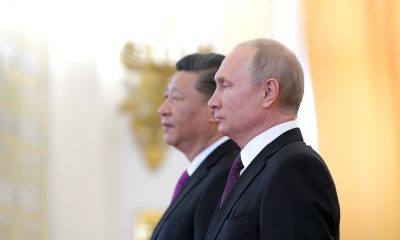Canada News
How to protect yourself from media manipulation on energy issues and other contentious matters

It originated in a 2012 media firestorm over the Enbridge Northern Gateway pipeline, simmered its way through some seven years of conflict over the Trans Mountain Pipeline expansion and is still present in news releases from the Alberta government. (File Photo: Trans Mountain/Facebook)
When my kids were little, we would play a game during the TV commercials.
What was the main message, I would ask. To whom was it targeted? Did you find it convincing? Why or why not?
I hoped this would encourage critical thinking, build some awareness of unscrupulous messaging and wrest them from the grips of a consumer culture. Without realizing it, I was teaching them about “media frames.”
Frames are selective storylines intended to sway decision-makers or public opinion, often with provocative words or images. The power of framing comes from defining the terms of a debate without the audience realizing it has occurred.
Being aware of frames reduces our vulnerability to them. Once we can recognize frames and framing techniques, they lose their power, and we can focus on the arguments, not the frame.
Manipulative or responsible?
“Defund the Police” is a recent example of a frame that targets racially motivated police brutality and advocates for moving a portion of police budgets to other arenas, such as mental health care. The original premise of this frame was that some police tasks should be managed by social workers or through community-building initiatives in a new model of public safety.
The frame was co-opted by self-professed “law-and-order” advocates to suggest the “defunders” were violent anarchists who wanted to abolish the police, threatening public safety and leading to widespread unrest. Another group adopted the defund frame with an eye to removing policing altogether, weakening its original intent and fuelling the “law-and-order” counter-frame.
Frames work by activating or “priming” already held feelings, ideas and values. When they have broad appeal, we see them as common sense. The “law-and-order” counter-frame builds on a deeply rooted common-sense frame that sees police as protectors.
People skilled in the art of shaping frames can define situations, set the terms of debates, strategically mobilize supporters, hobble opponents and ultimately determine outcomes. Framing can be manipulative and unethical, necessary and responsible, brilliant and dangerous.
‘Anti-petroleum extremists’
My research on contentious energy conflicts on Canada’s West Coast found no frame was more influential in advancing a conflict narrative than one I labelled “anti-petroleum extremists.”
It originated in a 2012 media firestorm over the Enbridge Northern Gateway pipeline, simmered its way through some seven years of conflict over the Trans Mountain Pipeline expansion and is still present in news releases from the Alberta government.
Read more:
The urgent need for media literacy in an age of annihilation
Rather than raise awareness of bombings targeting B.C. gas pipelines and other violent events affecting and threatening people in Canada’s oil and gas industry, former prime minister Stephen Harper’s Conservative government advanced a frame that portrayed pipeline opponents as foreign-funded radicals who were unfairly trying to stop major projects no matter what the cost to Canadian families.
The frame was amplified by anti-terrorism legislation suggesting pipeline protesters threatened national security, documents such as RCMP intelligence reports that suggested protesters were under surveillance and widespread audits of environmental organizations.
Framing techniques
At least five framing techniques were used to create the “anti-petroleum extremists” frame.
- Identity: “Us-versus-them” frames characterize a situation to be more about the players and less about the issues. Blame was squarely placed on a stereotypical them with moral indignation and an intent to legitimize action to end the perceived injustice.
- Hot values: Like all contentious frames, “anti-petroleum extremists” was embedded in “hot values” more than “cold” information such as industry statistics or even “warm” stories about resource-dependent families.
For example, fossil fuels may be valued as sources of great wealth and progress, or derided as threats to clean air and water and planetary stability. In a framing contest, frames attached to strong values will trounce ones that are technical or narrative.
- Masculinity: Under this frame, leadership is about decisiveness, power and strength. In feminine frames, it’s about bridging differences, establishing relationships and questioning one’s own position.
- Breaking the monopoly on emotion: By describing environmentalists as “foreign-funded,” the Harper government hijacked a common anti-oilsands frame, namely that foreign wealth had tremendous influence over Canadian energy and environmental policies.
- Villain, victim and hero: The Harper government portrayed itself as heroic, protecting the Canadian public and important investors from villanous extremists. Protesters had a similar frame, where the heroes were reasonable people with legitimate concerns safeguarding a sustainable future.
‘No choice’
As the Harper government weakened environmental laws and legal decisions failed to provide relief, many people began to feel like they were running out of options. This helped spur a “no choice” frame.
Many “no choice” advocates did not see themselves as extremist and felt they — not only the environment — were under assault, transforming the frame into an identity frame.
For Indigenous people opposed to the project, the “anti-petroleum extremists” frame was another intolerable affront to First Nations and territories overly consumed by development.
For some other research participants, there was a sense that Canadianism was under attack.
The “no choice” frame became linked to a hot values frame with villain, victim, hero properties called “restoring democracy” in the lead up to the 2015 federal election. In this frame, moral justice trumped legal justice, since legislators and regulators were seen as aligned with industry and not worthy of trust.
Read more:
We could power a new green movement by talking about energy change
“Restoring democracy” would become the most prominent frame in mainstream news, and it was this frame to which Liberal Prime Minister Justin Trudeau first responded, promising extensive opportunities for public input.
Building frame literacy
Powerful players in government and industry have ample resources and experience with media messaging. To help level the playing field, I challenge you to identify frames in media.
Are they being used to some political advantage? What values are evident? Are there counter-frames? What framing techniques are used?
Are the frames in non-profit, industry or government media? Are they in mainstream news? How frequently are you seeing them in each type of media?
Is there an emerging “no choice” frame, signalling a social tipping point?
As you build frame literacy, you will protect yourself from media manipulation — and likely have a little fun.![]()
![]()
Holly Clermont, Post-doctoral fellow, Environment, Community and Health Observatory, University of Northern British Columbia
This article is republished from The Conversation under a Creative Commons license. Read the original article.





















